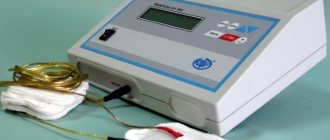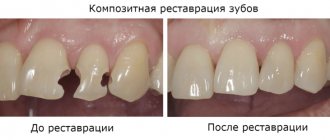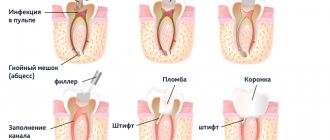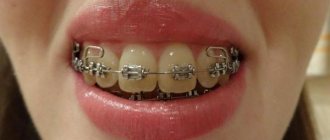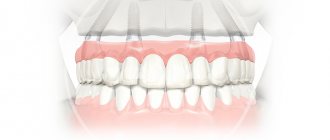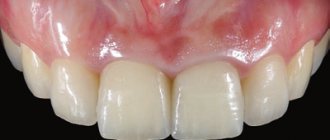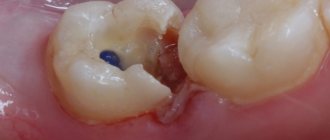Causes
The reasons for the formation of a through communication between the oral cavity and the nasopharynx are various. This is a tooth extraction carried out with disturbances or complications, pathological processes. Perforation when removing the first or second molar or premolar occurs for the following reasons:
- improperly formed socket;
- violations during tooth extraction;
- anatomical features of the upper jaw, low location of the sinus floor;
- pathological processes causing destruction of tissue, bone septum;
- cysts, tumor processes, chronic periodontitis.
Symptoms
In rare cases of minor perforation, the anastomosis closes on its own. Much more often, the defect triggers inflammation processes, sinusitis. Depending on the form of the disease, the clinical picture differs:
- Changes in sensation associated with the entry of liquids and air into the sinus,
- The appearance of a timbre defect (“pronunciation”),
- Changes in symmetry, configuration of external facial tissues,
- Drainage of mucous contents from the nose when tilting the head,
- The presence of an odor that is equally felt by the nose and mouth.
The variability of the pathomorphological picture is influenced by the duration, activity of inflammation, and the patient’s immune status.
Certain stages of the disease occur without external manifestations. If complaints related to the period after tooth extraction are detected, the doctor will conduct an air test and probe the hole. Additionally, X-ray diagnostics will be prescribed.
Diagnostics
To identify pathology, the doctor prescribes diagnostics - a nasal test and x-ray examination. The test is carried out quite simply: the patient pinches his nose, after which he is asked to take a deep nasal exhalation. If there is a perforation, a stream of air enters the mouth, and a foamy, bloody liquid appears on the hole. With the help of X-rays, the doctor has the opportunity to examine the pathology inside, determine the location and extent of the lesion, and see all extraneous fragments.
Treatment methods
Treatment of pathology is carried out using various methods:
- moving the flap from the mucous periosteal region of the cheek;
- covering with membranes;
- plastic surgery of the anterior wall for sinusitis.
The choice of method depends on the characteristics and course of the disease. The doctor conducts a preliminary examination and determines what the treatment will be. The main goal is to eliminate the message, reduce injuries and eliminate the development of relapses. The method is effective and shows good results. The downside is additional tissue trauma when harvesting a flap with subsequent suturing.
Repositioning the flap from the periosteal region is a popular method that is highly effective. The doctor first determines the place where the donor flap will be taken, collects it and sutures the wound. Next, the flap is transferred to the surgical area, and new tissue is formed. The treatment is carried out in two stages; in the communication area, the trapezoidal flap is attached with sutures.
The membrane is used under local anesthesia. For work, a flap of the periosteal part is cut out, which is then shifted upward. Next, the frontal part is opened slightly, the doctor performs trepanation, maxillary sinusotomy and removes all foreign tissue. The area is tamponed, the doctor installs a turunda, leaving the end protruding from the nasal passage. To maintain mobility, the flap at the base is trimmed slightly, and the opening is closed with a membrane. The defect is overlapped by 3 millimeters, then the pathological area is closed, and interrupted sutures are applied. The membrane dissolves as it heals, which is an advantage of this method.
Plastic surgery for frontal sinusitis involves submucosal resection of the nasal septum with luxation of the median concha and a retrograde incision for the lower element of the branch. This opens access to the anastomosis and provides ease of work. It is this area that is usually affected by polyps, so in parallel with the main treatment, the doctor removes foreign inclusions with thickened mucous tissue.
The next step is an arched cavity incision from the middle of the eyebrow to the transition to the slope of the nose, dissection of the periosteum with exposure of the sinus. The doctor performs an inspection of the sinus with a chisel, removing the affected mucous membrane, polyps, granulants, and accumulations of pus. During work, it is necessary to preserve as much healthy tissue as possible, which requires a certain amount of experience from the doctor.
At the final stage, the patency of the nasal canal is checked under the control of an endoscope. If there are no complications, the tissues are sutured, a cosmetic suture is placed on the face, which allows maintaining external aesthetics.
Using a flap
The treatment technique using a trapezoidal mucoperiosteal flap includes the following steps:
- determining the area where the flap will be taken, cutting it out;
- excision of the walls of the fistula and installation of the flap in place;
- covering the anastomosis, suturing the edges.
The technique is specially developed for the treatment of such pathology. It places special demands on the doctor’s hoof and strict adherence to the surgical protocol.
The doctor cuts out a trapezoidal flap; the donor site is the mucous tissue of the periosteal region. If there are indications, a maxillary sinusotomy is performed, that is, all tissues with signs of pathological damage and foreign inclusions are removed from the sinus cavity. The edges are refreshed, and curettage is performed before treating the hole with antiseptics. The differences between the method are:
- formation of lining in the sinus cavity, subsequent lining of the membrane at the mouth;
- formation of a layer by displacing the flap to the defect area;
- suturing according to the U-shaped principle, which ensures accelerated healing of the surgical area.
Result:
- layers of tissue are formed with a significant increase in quality;
- the development of relapses is prevented;
- eliminates the need for repeated intervention.
The treatment method is indicated for the formation of tissue perforation during sinusitis, during general therapy for message formation.
Preventive measures
Prevention eliminates the development of the problem, but for this the patient must regularly visit the doctor and carry out sanitary measures. This allows you to prevent the development of periodontitis and maintain the integrity and structure of bone tissue. Preventive measures also include proper treatment and no scraping of the socket during tooth extraction. The doctor needs to correctly connect the edges of the gums, which allows for the formation of a blood clot inside and the formation of a protective barrier to infection.
Veterinary clinic of Dr. Shubin
Definition
Oronasal or oroantral fistula is a defect of the gum, palate, maxillary or incisive bone, leading to the formation of a connection between the oral and nasal cavities. An oronasal fistula is defined as a defect located rostral to the mesial roots of the maxillary third premolar; a defect located distal to this location is considered an oroantral fistula.
Etiopathogenesis
An oronasal fistula develops for a variety of reasons, these may include pathologies such as periodontal disease, trauma, neoplasm, electrical/caustic burns, and iatrogenic factors secondary to oral surgery (especially maxillary canine extractions). Additionally, oronasal fistula may occur secondary to traumatic malocclusion, eosinophilic granuloma, and rhinolithiasis. And yet, the fundamental reason for the formation of an oronasal fistula is periodontal disease, and it is this factor that will be discussed further in more detail.
Periodontitis leads to osteoclastic bone resorption; if left untreated, resorption can continue until tooth loss. However, the tooth can be held in the socket by unaffected areas of the root system (other roots of a multi-rooted tooth, areas of an intact root), and bone resorption continues until the invasion of the nasal cavity. The formation of an oronasal fistula is observed with the progression of periodontitis on the teeth of the upper jaw towards the apex (apical).
The most common cause of the formation of an oronasal fistula is periodontal disease of the upper canines; the roots of these teeth are adjacent to the nasal cavity, run parallel to it and are separated only by a thin sheet of bone tissue. Periodontal disease destroys the thin layer of bone along its normal attachment to the tooth root. Resorption of the bone border leads to the connection of the oral and nasal cavities; oral bacteria, together with food particles and other debris, penetrate the nasal cavity and are responsible for further infectious inflammation (sinusitis). The nasal cavity infection does not stop until the oronasal fistula is surgically corrected.
Clinical signs
Oronasal fistula induced by periodontitis is more often observed in older dogs of small breeds. Chondrodystrophic breeds are strictly predisposed to fistula formation. However, the disease can develop in any breed of dog at any age, as well as in cats.
The main reasons for visiting a veterinary clinic are such manifestations as: chronic discharge from the nasal cavity (blood or pus), sneezing, and sometimes anorexia and halitosis can occur. In a small percentage of cases, signs of an oronasal fistula are easily detected during a dental examination; in most cases, the presence of a fistula is determined under anesthesia, using a dental probe. When a periodontal probe is introduced, pockets of considerable size are found on the palatal surface of the teeth of the upper jaw without resting on the bottom. In addition, after manipulation of the probe, blood may appear in the nasal cavity.
It is important to note that a significant periodontal pocket may develop before the formation of a fistula and may be treated in a different way (different from the treatment of an oronasal fistula). Interestingly, a fistula can develop when the remaining periodontal tissue is relatively healthy. This may include other surfaces of the teeth involved.
Diagnostics
The final diagnosis is made based on clinical signs and periodontal examination with a probe under anesthesia. If there is any doubt about alternative sources of the fistula, histopathological examination may be required before repair. In addition, if a broader problem is being considered, CT scanning can be of significant help. Dental radiography should always be performed to assess the future surgical site, however, it should not be relied upon when diagnosing an oronasal fistula per se.
In differential diagnosis, special attention should be paid to neoplasms.
Treatment
Oronasal fistula induced by periodontitis
At this point in the disease, the only solution to the problem is extraction of the affected tooth with covering the defect with a full-thickness mucoperiosteal flap. A single mucogingival flap technique (without a palatal flap) is sufficient in most cases of periodontitis-induced oronasal fistula, providing sufficient flap size to maintain blood flow. Very large or recurrent cases may require a double flap technique (extremely rare).
By identifying the periodontal pocket before the development of an oronasal fistula (especially in the canine teeth), periodontal surgery under guided tissue regeneration may be successful in preventing the disease. If the disease is severe on one side, it is customary to control the opposite tooth.
Oronasal fistula induced by trauma, neoplasm or burn
These cases may be more difficult to treat, primarily due to the involvement of palatal tissue, which has poor elasticity and therefore requires an advanced flap technique to cover the defect without tension.
Oronasal fistulas of significant size or chronic cases that do not respond to conventional surgical techniques may require treatment with alternative methods (eg, use of a silastic obturator or creation of a dorsal tongue flap).
Valery Shubin, veterinarian, Balakovo
